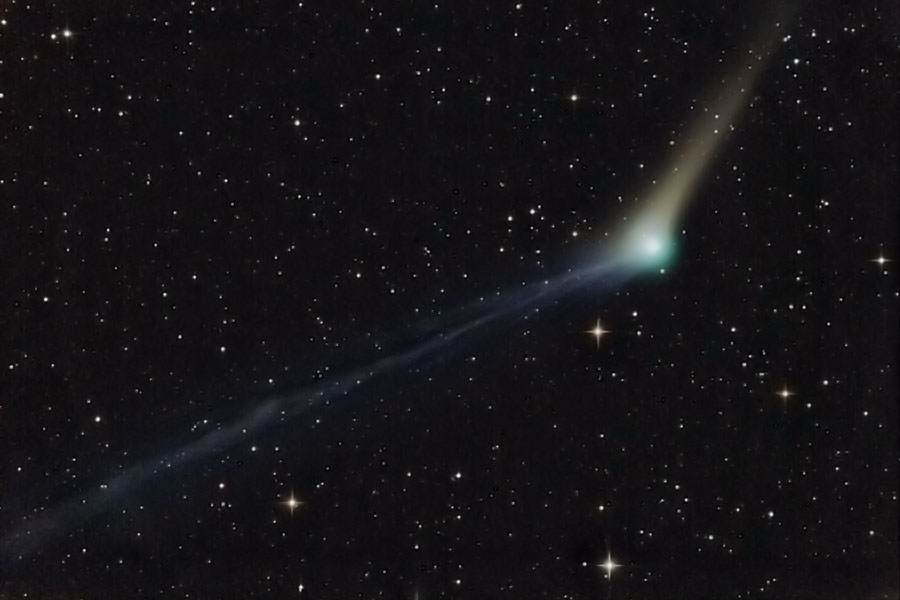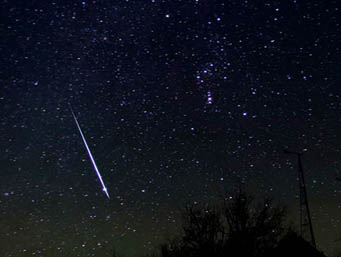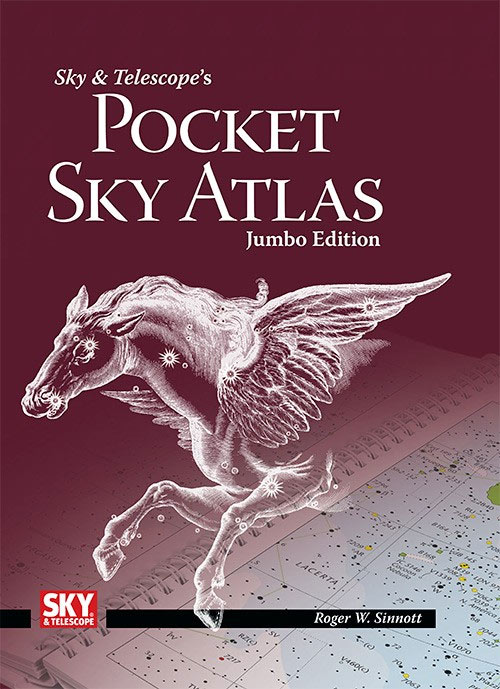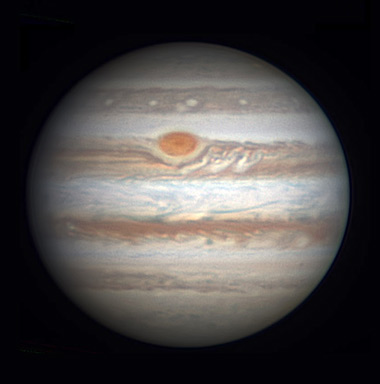
Comet Catalina (C/2013 US10) is running about a magnitude fainter than predicted, now that it has emerged into view low in the east at dawn. It's likely to stay at 6th magnitude as it climbs high into the predawn eastern sky through December and January. This week it's near Venus. See the December Sky & Telescope, page 45, or our article Get a Predawn Peek of Comet Catalina. Both provide finder charts.
________________________
Friday, December 11
• Sirius is, famously, the brightest star in the night sky. Have you ever tried to catch Sirius rising? If you can find a good view down to the east-southeast horizon, watch for Sirius emerging into view. It's about two fists at arm's length below Orion's Belt. It rises around 7:30 to 8:30 p.m. now (depending on where you live).
When a star is very low, it tends to twinkle quite slowly and often in vivid colors. Sirius is bright enough to show these effects especially well.
• Keep an eye out for early Geminid meteors! The shower is due to peak late Sunday and Monday nights.
• New Moon (exact at 5:29 a.m. EST).
Saturday, December 12
• Vega still glitters brightly in the northwest early these evenings. Deneb is the brightest star above it, in second place. Deneb is also the head of the big Northern Cross, which now extends to Deneb's lower left. By 9 or 10 p.m. the Northern Cross swings down and around to plant itself upright on the northwest horizon (as seen from mid-northern latitudes).
Sunday, December 13

• The Geminid meteor shower should reach its peak late tonight and tomorrow night, December 13–14 and 14–15. The sky will be moonless. See the December Sky & Telescope, page 44, or our online article Geminids in 2015: Moonless and Marvelous.
Monday, December 14
• The Geminids continue. See above.
• Sirius, the Dog Star, and Procyon, the Little Dog Star 25° to its left, shine low in the southeast and east by 9 p.m. If you live around latitude 30° N (Tijuana, New Orleans, Jacksonville), the two canine stars will shine at the same height above your horizon. If you're north of that latitude, Procyon will be higher. If you're south of there, Sirius will be the higher one.
Tuesday, December 15
• The waxing crescent Moon hangs in the southwest at nightfall. Look above it for the two brightest stars of Aquarius: Beta (β) and, higher, Alpha (α) Aquarii. Alpha is the bottom-right point of the Water Jar asterism.
Wednesday, December 16
• The Moon this evening stands midway between Fomalhaut, to its lower left, and Enif, the Nose of Pegasus, to its upper right. The Moon is about 20° from each.
Thursday, December 17
• The Moon shines more or less under the western (right) side of the Great Square of Pegasus at nightfall. Can you see the Moon moving with respect to this line as the hours go by?
• Algol should be at minimum brightness, magnitude 3.4 instead of its usual 2.1, for a couple of hours centered on 8:48 p.m. EST, according to revised predictions.
Friday, December 18
• First-quarter Moon (exact at 10:14 a.m. EST). This evening the Moon shines more or less under the eastern (left) side of the Great Square of Pegasus. Can you see the Moon moving with respect to this line as the hours go by?
Saturday, December 19
• The little Pleiades cluster shines very high in the southeast after dinnertime, no bigger than your fingertip at arm's length. How many Pleiads can you count with your unaided eye? Take your time and keep looking. Most people can count 6. With sharp eyesight, a good dark sky, and dark-adapted eyes, you may be able to make out 8 or 9.
__________________________
Want to become a better astronomer? Learn your way around the constellations. They're the key to locating everything fainter and deeper to hunt with binoculars or a telescope.
This is an outdoor nature hobby. For an easy-to-use constellation guide covering the whole evening sky, use the big monthly map in the center of each issue of Sky & Telescope, the essential guide to astronomy.

Once you get a telescope, to put it to good use you'll need a detailed, large-scale sky atlas (set of charts). The basic standard is the Pocket Sky Atlas (in either the original or new Jumbo Edition), which shows stars to magnitude 7.6.
Next up is the larger and deeper Sky Atlas 2000.0, plotting stars to magnitude 8.5, nearly three times as many. Next up, once you know your way around, is the even larger Uranometria 2000.0 (stars to magnitude 9.75). And read how to use sky charts with a telescope.
You'll also want a good deep-sky guidebook, such as Sue French's Deep-Sky Wonders collection (which includes its own charts), Sky Atlas 2000.0 Companion by Strong and Sinnott, or the bigger Night Sky Observer's Guide by Kepple and Sanner.
Can a computerized telescope replace charts? Not for beginners, I don't think, and not on mounts and tripods that are less than top-quality mechanically (meaning heavy and expensive). As Terence Dickinson and Alan Dyer say in their Backyard Astronomer's Guide, "A full appreciation of the universe cannot come without developing the skills to find things in the sky and understanding how the sky works. This knowledge comes only by spending time under the stars with star maps in hand."
This Week's Planet Roundup

Mercury (magnitude –0.6) is emerging from the glare of sunset into evening twilight view. Look for it about 20 or 30 minutes after sunset just above the southwest horizon — the later in the week the better. Binoculars will help. Mercury is on its way up to a fine showing through Christmas and New Year's.
Venus, Mars, and Jupiter form an ever-lengthening diagonal line in early dawn, running upward from southeast to south. Low Venus and high Jupiter are now separated by about 50°. Fainter Mars is between them, closer to Venus. A little below Mars is Spica. Venus shines at magnitude –4.2. Jupiter is –2.0, Mars is +1.4, and Spica is +1.0.
Saturn (magnitude +0.5) is deep in the glow of sunrise, very far lower left of Venus. You'll probably need binoculars.
Uranus (magnitude +5.8, in Pisces) and Neptune (magnitude +7.9, in Aquarius) are high in the southern sky early in the evening. Finder charts for Uranus and Neptune.
__________________________
All descriptions that relate to your horizon — including the words up, down, right, and left — are written for the world's mid-northern latitudes. Descriptions that also depend on longitude (mainly Moon positions) are for North America.
Eastern Standard Time (EST) is Universal Time (UT, UTC, or GMT) minus 5 hours.
__________________________
"I do not know what I may appear to the world; but to myself I seem to have been only like a boy playing on the seashore, and diverting myself in now and then finding a smoother pebble or a prettier shell than ordinary, whilst the great ocean of truth lay all undiscovered before me."
— Isaac Newton, 1642–1727
(From the Memoirs of the Life, Writings, and Discoveries of Sir Isaac Newton, David Brewster, 1855)
 2
2








Comments
Jean Loup
December 14, 2015 at 12:46 pm
NO MAP? Really!!
You must be logged in to post a comment.
Norma Iris
December 16, 2015 at 1:39 am
Dear Alan MacRobert,
On December 13, 2015 I got to see the meteor showers! It was a surprise since I only remembered it from the local news announcements that day and decided to take a chance at my window. I saw Orion directly in front of the window and waited. I do have some light-pollution but still managed to see as many as 30 + (I counted and then stopped and just enjoyed them) before my neck started hurting. My camera is not good quality but I still tried throughout the entire time to capture something. I saw some faint while others were strong streaks. Many were to the left of Orion and below it. I stayed till past 2:00 A.M. I watched on Monday the 14 also. On Monday, I saw much fewer in the same general area and one small fireball streak heading downwards - it was very bright and seemed like that one would hit ground just beyond the open property of the Lee Boulevard Highway where I live. On Tuesday, at 10:00 P.M. just got to see only two. But I got to see them. Wonderful. Only used my eyes and the for the filtering out of light-pollution, I put my kitchen apron draped to the bottom of the window pane and the top pane was fine.
You must be logged in to post a comment.
You must be logged in to post a comment.